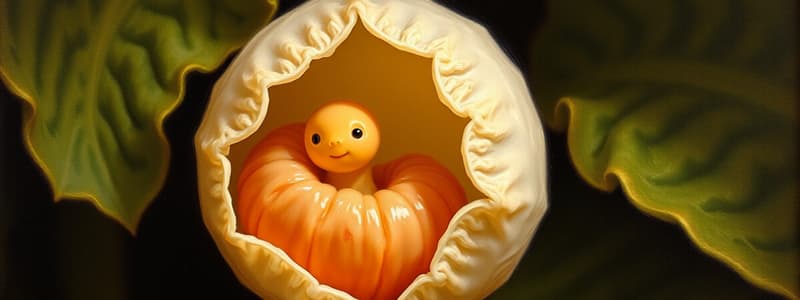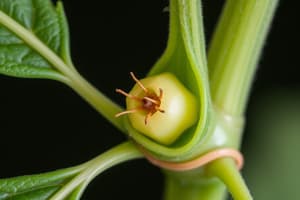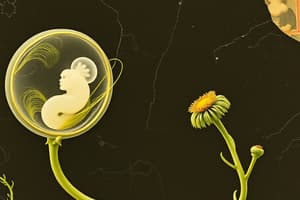Podcast
Questions and Answers
Which classification is NOT based on the type of germination?
Which classification is NOT based on the type of germination?
- Hypogeal Germination
- Endospermic Germination (correct)
- Hypo-epigeal Germination
- Epigeal Germination
Which of the following is an example of a pollination method involving birds?
Which of the following is an example of a pollination method involving birds?
- Anemophily
- Hydrophily
- Entomophily
- Ornithophily (correct)
What type of seed includes most food crops like cereals and beans?
What type of seed includes most food crops like cereals and beans?
- Recalcitrant seeds
- Hypoephytic seeds
- Endospermic seeds
- Orthodox seeds (correct)
In fertilization, how many nuclei participate in the process in angiosperms?
In fertilization, how many nuclei participate in the process in angiosperms?
Which of the following seeds are known for their ability to withstand drying and have extensive storage life?
Which of the following seeds are known for their ability to withstand drying and have extensive storage life?
Which of the following seeds is classified as non-endospermic?
Which of the following seeds is classified as non-endospermic?
What is the main purpose of pollen dissemination methods?
What is the main purpose of pollen dissemination methods?
Which of the following is an example of a seed with epigeal germination?
Which of the following is an example of a seed with epigeal germination?
What is the primary function of the seed coat?
What is the primary function of the seed coat?
Which of the following seed types has no endosperm at maturity?
Which of the following seed types has no endosperm at maturity?
Which of the following crops is classified as a non-endospermic dicot?
Which of the following crops is classified as a non-endospermic dicot?
Identify the type of germination where cotyledons emerge above the ground.
Identify the type of germination where cotyledons emerge above the ground.
Coconut is categorized as what type of endosperm?
Coconut is categorized as what type of endosperm?
Which part of the seed coat is derived from the outer integument?
Which part of the seed coat is derived from the outer integument?
What is a common feature of albuminous seeds?
What is a common feature of albuminous seeds?
The appendage known as 'caruncle' is found in which crop?
The appendage known as 'caruncle' is found in which crop?
Which of the following is classified as a gymnosperm based on cotyledon count?
Which of the following is classified as a gymnosperm based on cotyledon count?
What distinguishes unitegmic ovules from bitegmic ovules?
What distinguishes unitegmic ovules from bitegmic ovules?
Flashcards are hidden until you start studying
Study Notes
Embryo
- An embryo is an immature plant that develops into a new plant under suitable conditions.
- Contains one cotyledon in monocotyledons, two cotyledons in most dicotyledons, and two or more in gymnosperms.
- Examples of monocots include wheat, corn, rice, and lilies.
- Examples of dicots include legumes such as peas and beans, as well as tomatoes and oak trees.
Endosperm
- Albuminous seeds (endospermic): Seeds in which the endosperm remains until maturity; typical in most monocots like grains.
- Exalbuminous seeds (non-endospermic): Seeds where the endosperm is consumed during development, leading to no endosperm at maturity.
- Examples of endospermic monocots include maize and coconuts.
- Non-endospermic dicots include all legumes (e.g., peas, beans) and various fruits like mango.
- Coconut has a liquid endosperm, with carbohydrates in cereals, proteins in legumes, and fats in castor and peanuts.
Seed Coat
- Composed of two layers: the outer layer (Testa) and the inner layer (Tegmen).
- Protects the embryo from mechanical damage and dehydration.
- Unitegmic: Ovules with one integument.
- Bitegmic: Ovules with two integuments; can derive seed coat from either or both integuments.
Appendages of Seed
- Awn: Found in paddy.
- Hilum: Present in pulses.
- Caruncle: Seen in castor and tapioca.
- Aril: Found in nutmeg.
- Hairs: Present in cotton.
- Wings: Characteristic of moringa.
Classification of Seeds Based on Germination
- Hypogeal Germination: Epicotyl elongates while cotyledons remain below ground; common in monocots and several legumes.
- Epigeal Germination: Cotyledons emerge above ground; examples include beans and castor.
Classification of Seed
- Based on Usage: Includes cereals, oil seeds, pulses, fiber, vegetables, and medicinal species.
- Based on Cotyledons: Division into monocots and dicots.
- Endosperm Type: Endospermic (cereals) vs. non-endospermic (legumes).
- Germination Type:
- Hypogeal: Monocots like maize and legumes.
- Epigeal: Beans, cotton, cucumber, and others.
- Storage Behavior:
- Orthodox Seeds: Most food crops, beans, and fruits (e.g., mango, apple).
- Recalcitrant Seeds: Forest and horticultural crops (e.g., avocado, mango).
Pollination
- Methods of Pollination:
- Wind: Anemophily.
- Water: Hydrophily.
- Insects: Entomophily.
- Birds: Ornithophily.
- Snails: Malacophily (e.g., Colocasia).
- Wasps: Waspophily (e.g., fig).
- Flies: Myophily.
- Bats: Chiropterophily (e.g., agave).
Fertilization
- Involves fusion of male and female gametes forming an embryo.
- Embryo sac consists of 7 cells and 8 nuclei.
- The egg apparatus at the micropyle includes one egg cell and two synergids; two polar nuclei in the center, and three antipodal cells at the chalazal end.
- In angiosperms, fertilization involves double fertilization with participation of two male nuclei.
Studying That Suits You
Use AI to generate personalized quizzes and flashcards to suit your learning preferences.




